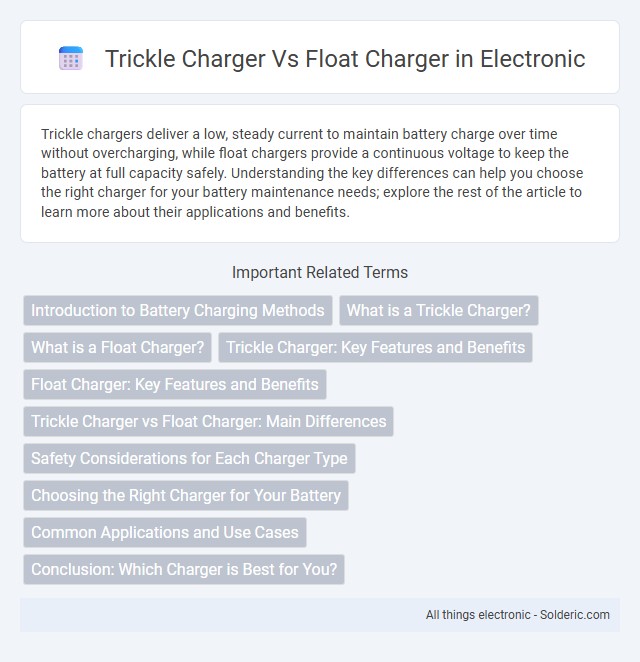Trickle chargers deliver a low, steady current to maintain battery charge over time without overcharging, while float chargers provide a continuous voltage to keep the battery at full capacity safely. Understanding the key differences can help you choose the right charger for your battery maintenance needs; explore the rest of the article to learn more about their applications and benefits.
Comparison Table
| Feature | Trickle Charger | Float Charger |
|---|---|---|
| Purpose | Slowly charges battery to full capacity | Maintains full charge without overcharging |
| Charging Method | Constant low current supply | Variable voltage regulation |
| Battery Type Compatibility | Lead-acid, NiMH, NiCd | Lead-acid, AGM, Gel, Lithium |
| Overcharge Risk | Higher if left connected too long | Minimal due to smart regulation |
| Usage Duration | Short to moderate periods | Long-term battery maintenance |
| Typical Applications | Small vehicles, motorcycles, seasonal use | Cars, boats, RVs, standby power systems |
| Cost | Generally less expensive | Usually higher cost due to electronics |
| Battery Life Impact | Potentially reduces life if overcharged | Extends battery life with maintenance charging |
Introduction to Battery Charging Methods
Trickle chargers deliver a low, steady current to maintain a battery's charge without overcharging, making them ideal for long-term maintenance of small batteries. Float chargers provide a constant voltage that adjusts to the battery's needs, ensuring optimal charge levels and preventing battery damage in larger or more complex systems. Understanding these differences helps you choose the right charger for efficient and safe battery maintenance.
What is a Trickle Charger?
A trickle charger is a low-amperage device designed to charge a battery slowly and maintain its charge over time without overcharging. It supplies a continuous, gentle current that compensates for self-discharge, making it ideal for long-term battery maintenance. Your battery's health benefits from using a trickle charger to prevent damage caused by constant high voltage or excessive charging.
What is a Float Charger?
A float charger maintains a battery's charge by providing a low, continuous voltage that compensates for self-discharge without overcharging. Unlike a trickle charger, which supplies a constant small current, a float charger adjusts output to keep the battery at its optimal voltage level. Your battery benefits from extended life and readiness when using a float charger for long-term maintenance.
Trickle Charger: Key Features and Benefits
Trickle chargers deliver a low, steady current to maintain your battery's charge without overcharging, making them ideal for long-term battery maintenance. They are designed to prevent battery discharge during extended periods of inactivity, preserving battery life and ensuring optimal performance. Your battery's efficiency and longevity are enhanced by the gentle charging approach, which reduces the risk of damage compared to more aggressive charging methods.
Float Charger: Key Features and Benefits
Float chargers maintain a constant, low voltage to keep batteries fully charged without overcharging, making them ideal for long-term battery maintenance. They feature automatic voltage regulation, ensuring minimal battery wear and extended lifespan. Suitable for lead-acid and AGM batteries, float chargers enhance reliability and reduce the risk of sulfation and battery damage.
Trickle Charger vs Float Charger: Main Differences
Trickle chargers supply a slow, continuous charge to maintain battery voltage without overcharging, ideal for keeping batteries topped up during extended storage. Float chargers monitor battery voltage and deliver a regulated, lower current to maintain a full charge safely, preventing battery damage from overcharging. Your choice between a trickle charger and a float charger depends on the battery type and usage, with float chargers offering smarter, automated maintenance for long-term battery health.
Safety Considerations for Each Charger Type
Trickle chargers maintain a low, steady charge to prevent battery overcharging, making them safer for long-term battery maintenance without risking damage. Float chargers regulate voltage precisely to keep the battery at full charge without causing overheating, reducing the risk of acid leakage or battery swelling. Proper use of each charger type, including matching charger specifications to battery type, is essential to maximize safety and battery lifespan.
Choosing the Right Charger for Your Battery
Choosing the right charger for your battery depends on its type and usage patterns; trickle chargers deliver a low, steady charge to maintain battery health over extended periods, ideal for seasonal vehicles or infrequent use. Float chargers, on the other hand, supply a constant voltage to keep the battery fully charged without overcharging, making them suitable for batteries in continuous use or standby mode. Your decision should consider the battery chemistry, capacity, and how often you intend to charge it to ensure optimal performance and longevity.
Common Applications and Use Cases
Trickle chargers are commonly used for maintaining small batteries in motorcycles, lawn mowers, and classic cars by providing a low, steady charge to prevent battery discharge over time. Float chargers are ideal for applications requiring continuous battery maintenance, such as backup power systems and marine batteries, where they keep the battery fully charged without overcharging. Your choice depends on how often you use the battery and whether you need ongoing maintenance or a slow recharge after occasional use.
Conclusion: Which Charger is Best for You?
Choosing between a trickle charger and a float charger depends on your specific battery maintenance needs and usage patterns. A trickle charger is ideal for occasional use, delivering a low, continuous charge to slowly restore battery power without overcharging, making it suitable for small batteries and seasonal vehicles. Float chargers provide a consistent voltage that keeps batteries at full charge for extended periods, perfect for vehicles in storage or infrequent use, ensuring optimal battery health and longevity.
Trickle charger vs Float charger Infographic

 solderic.com
solderic.com